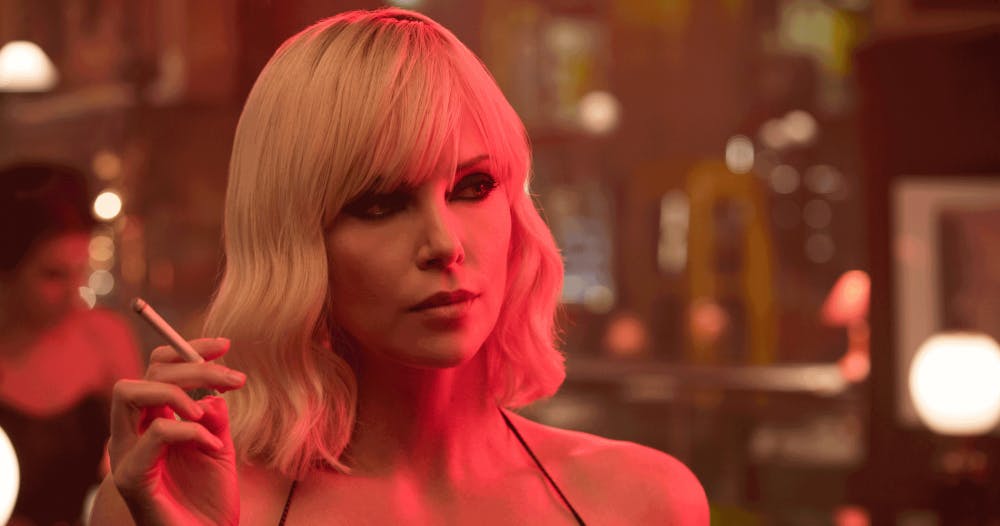Movie: “Atomic Blonde”
Director: David Leitch
Runtime: 1 hour 55 minutes
Release Date: July 28
Rating: C+
“Atomic Blonde” opens with one of American history’s most famous moments, setting the stage for filmic '80s mayhem with Reagan’s 1987 Berlin Wall speech. Just after the iconic “Mr. Gorbachev, tear down this wall,” though, the screen goes dark, and text marked with rebellious green spray paint informs the audience that “Atomic Blonde” is not “that story,” attempting to separate the tale of the “atomic” and blonde MI6 agent Lorraine Broughton (Charlize Theron) from that of the Reagan doctrine, the Cold War and '80s conservatism.
Structured as a series of flashbacks, most of the film is devoted to Broughton recounting the triumphs and failures of her mission to save a critical list of double agents from Communist hands and detailing her involvement with British station chief David Percival (James McAvoy) and French agent Delphine (Sophia Boutella). Listening to her complicated tale of intrigue are her MI6 superior (Toby Jones) and a CIA head (John Goodman). After Broughton finishes her narrative, the film’s timeline becomes linear for a third act in which the agent untangles the complicated plot and saves the day.The resolution makes way for a twist finish that drives home a pro-America, anti-Red posture not too far off from the worldview of the '80s conservatism that the film’s opening disclaimer seemingly eschews.
On the surface, David Leitch’s graphic novel-based spy movie is as cool as the Berlin air that surrounds its main characters. The icy-yet-sensual leading lady, excessive closeups of lips on cigarettes and tumblers of vodka — Soviet brand Stolichnaya vodka, to be exact — and constant moody blue lighting make for a sophisticated vibe that lives up to the highest expectations of the secret agent genre. An all-eighties soundtrack plays through the film without rhyme or reason, adding a continual, impersonal, synth-pop sound to Broughton’s escapades.
In terms of both scene construction and cinematography, the technical skill of the film’s many fight scenes is as cutting edge as the mise-en-scéne. Due to Leitch’s former career as a stunt double and partial direction of “John Wick,” the greatest strength of “Atomic Blonde” lies in the sequences when characters come to blows. The fight choreography and Jonathan Sela’s camera work combine to give fight scenes a visceral feel. The use of unique settings and weapons keep audience members engaged, and it’s just plain entertaining to watch Broughton’s capers on the big screen. Regarding the various elements of filmic style, “Atomic Blonde” is not quite the '80s, but is instead a sleek and advanced version with heightened cool.
Taking a look at the values behind “Atomic Blonde,” however, yields a different — and more dated — result. In the end of the film, it’s Agent Broughton (who may be more of an American girl than it seems at first appearance), Goodman’s CIA chief and the good old U.S.A. who are victorious. While the film briefly nods at anti-authoritarianism with McAvoy’s punkish character and a scene with Public Enemy’s “Fight The Power,” overall it’s a nationalist film, attempting to bring the hyper-patriotism of many conservatives in the '80s into 2017. In short, “Atomic Blonde” sees the world from the perspective of the middle-aged conservative viewer — one who voted Reagan-Bush and who still believes that America reigns supreme over other nations’ attempts to either aid or destroy its red-blooded soil.
In addition to nationalism, there is a another criterion of this imaginary '80s conservative from whom “Atomic Blonde” draws its inspiration — heterosexual manhood. The film is as pro-male as it is pro-America in terms of worldview, thanks largely to the blonde centerpiece of its title. Often objectified, Broughton is a sort of Bond Girl who also manages to knock out some bad guys and eventually save the day. Rather than focus on Broughton’s capabilities as an agent, the film focuses on her infinite collection of lacy lingerie, her penchant for using sexuality to do her job and a fling that she has with a fellow female agent — male-gaze-dominated sex scene between the two included. Unlike male secret agents of similarly-made films, Broughton encounters numerous setbacks and accidental, unnecessary casualties, and is nude or scantily clad for one too many scenes. The presence of a female lead in “Atomic Blonde” does little to cancel out its sexism, coloring the film with a dangerously subtle misogyny.
Viewers can see this film for the smooth tunes and action scenes, or stay home and skip the dated worldview. “Atomic Blonde” looks good on the surface, but suffers internally from hyper-Americanism and sexism that stays decades behind its smooth-as-silk exterior — making its impact on this summer's blockbuster lineup somewhat less than atomic.

